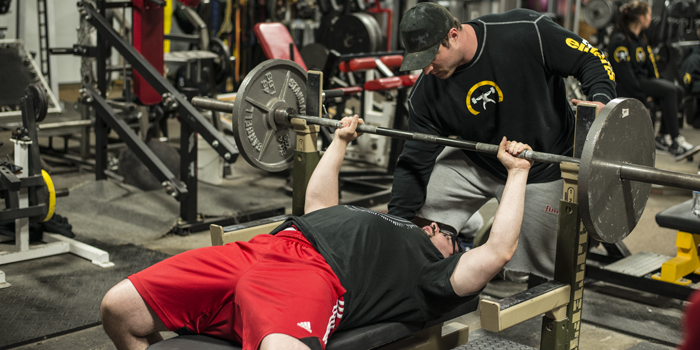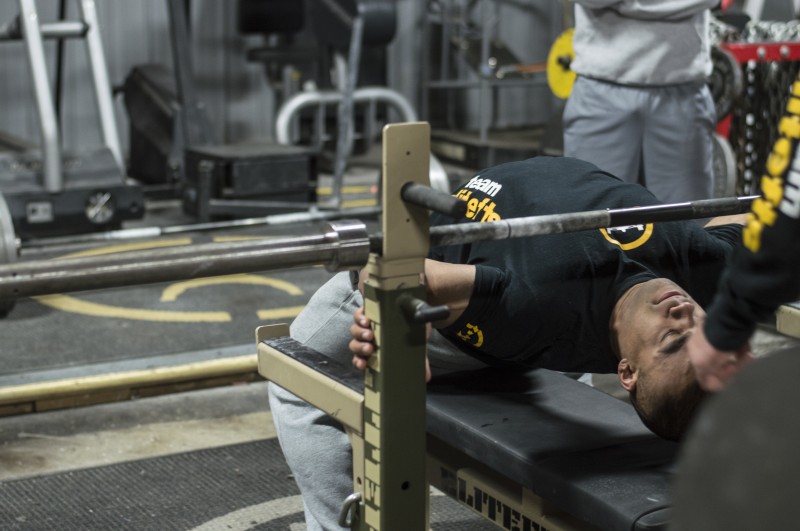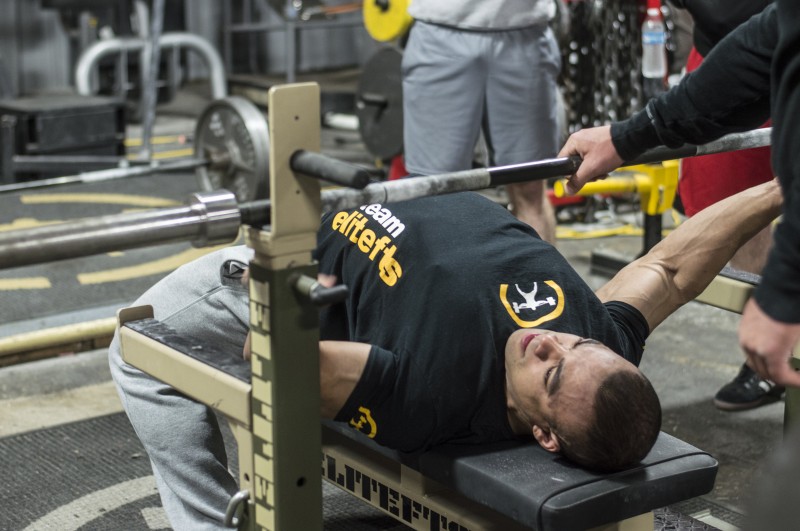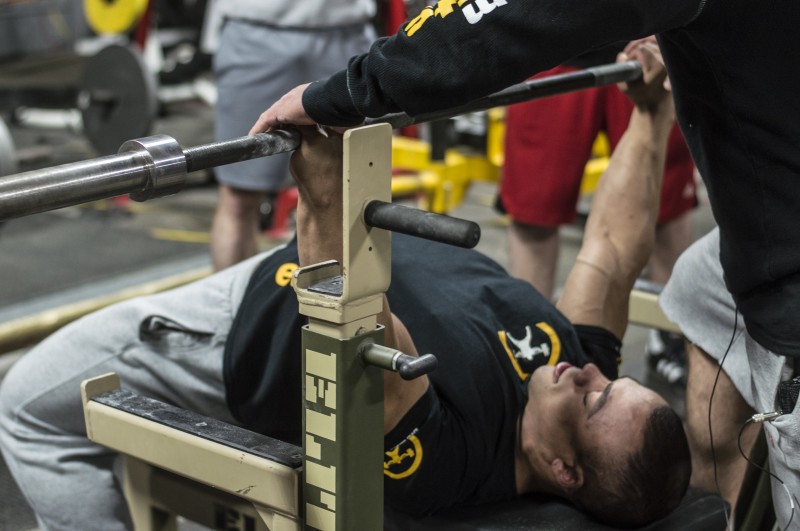
Allow me to begin with a couple of concessions. This is mainly to avoid any misplaced rage that could likely come my way after reading this article.
- The advice given here is aimed at those who want to get STRONGER in a specific lift.
- Primarily, this article is aimed at novice/intermediate, raw lifters, not advanced geared or weight class athletes.
Let me first state how exactly I came to write the article that you are about to read.
It was 5:30 AM on a dreary Monday morning a few weeks back and I was trawling through my Facebook feed as I sipped on my first coffee of the day, mentally preparing myself to write my first batch of Strongman workouts to be utilized by old clients at a new training facility.
As I scrolled down I noticed that a video had been posted up by a well-known fitness professional here in the UK. This guy has a company that in part employs (supposedly) top of the line personal trainers. The post was about how to improve your weak points on the bench press as a raw lifter: "Board presses are a great way to improve lockout strength and bring up your bench press numbers," he proclaimed.
First of all, I have never met a raw lifter who couldn’t lock out at least 20-30 pounds more weight during a board press than they could actually bench through a full range of motion. Try it yourself and see if this isn’t the case for you. If it is then you will know immediately that your lockout is not what is holding back your progress. By all means, train it all you like, but if you can’t get the bar moving off your chest or through the mid-point, your lockout strength is largely irrelevant.
So, I click on the video to see a guy perform a grueling set of 5-board presses at 225 pounds. Let me tell you, it looked tough.
My immediate thought was, "this guy definitely does have a weak point, but it’s not his lockout that’s the problem — it’s his entire body!"
Hell, you could have him do a year of board presses and push downs and I guarantee you his bench will not budge. This guy just needs to get strong, period. No amount of isolation work on the chest, arms, back or shoulders will make up for the fact that this ‘trainer’ is weak as a kitten.
To become truly strong you must be exposed to increasingly heavy loads over a long period of time, and whilst it is true that you can get plenty of volume from 5 sets of 20 reps on 55-pound leg extensions, as a novice it is highly unlikely that this exercise is going to be the magic key that bumps your squat up from 315 pounds to 500 pounds. The overwhelming majority who have squatted 500 pounds for reps (raw) probably didn’t get there by focussing on "special exercises" and occasionally maxing out. They will have worked up to it via a well thought-out linear progression, over a period of potentially many years, eating enough to support their efforts, and will almost certainly have dealt with injuries and other setbacks along the way. At this point they may well need to add some bodybuilding movements, but my point is that you have to earn the right to lift weight that mere mortals cannot accidentally lift after attending the gym for three sessions. We all know naturally strong individuals, but you will not see a person with minimal exposure to lifting simply walk into a gym and dominate a 500-pound squat, regardless of how big or genetically strong they are.
I know coaches who proclaim, "You don’t need to be able to lift 500 pounds to be able to teach someone to squat" and whilst technically this is true, my answer to that is that you should always be wary when you can out lift the person you are paying to make you strong. Being under a really heavy bar teaches many lessons that cannot be learned from a textbook or repping light weights. How can you truly help someone achieve their goals when you have no idea what it feels like to have two and a half times your own bodyweight on your back?
I would like to make a statement that some will agree with and many will not.
225 pounds is not a strong bench press. If you can bang out 5 reps at this weight, do not be fooled into thinking this is anything other than completely achievable for nearly any male given the appropriate training and time scale. I say this not to bash anyone’s achievements. On the contrary: My initial induction into the gym at 24 years old saw me fail to complete 10 reps of a bench press using 25-pound dumbells. My first barbell bench press session some time later produced a one-rep max of 135 pounds. I was stoked! Progress should always be immensely gratifying regardless of what anyone else is lifting because it is exactly that. Progress.
What I am attempting to do here is provide some context for the advice I am about to give to some of you who believe they have ‘weak points’ in any of the three big lifts. I like to use the bench press as an example simply because it has been the most problematic lift for me over the years. I’m 6’1 with long, gangly arms and because of this genetic nose tweak, I have always struggled to lift anything resembling half decent weight. Until last year…
Up until 2015 I had pretty much always benched once per week. That’s not to say that I didn’t throw in plenty of dumbbell work during another session or do a ton of overhead pressing and push ups. But the basic, straight bar bench press was completed just one time in seven days. I had read time and again that high volume dumbbell presses would build muscle and help with bringing weight off of the chest. I knew that skull crushers would build my triceps and help with my lockout. So I did these and other variations religiously. I was slowly gaining weight at about two pounds per month so naturally there was no real reason that things should not progress nicely. But I was stuck at a 315-pound bench and had been for probably two years.
RELATED: How to Fix Your Bench Press: Programming Issues and Assistance Work
I remember filming a top set one day to try and figure out exactly where my weak point was, in the vain hope of being able to correct the issue. And that’s when I realized what an absolute munson of a bench press I had. I suffered from numerous issues. If I lowered the weight in a controlled fashion I often struggled pressing the bar off of my chest, so I would drop it fast onto my sternum and aim to take advantage of the stretch reflex at the bottom. I also wasn’t particularly tight on the bench—I would wriggle around a bit and tap my feet—and when I did attempt to drive the bar back up I would raise my hips.
In general, the whole display was a pretty sorry sight to endure.
I didn’t have any real weak points as such; the whole embarrassing charade demonstrated that in the bench press, if using proper and correct form, I was just weak. Plain and simple.
I relied on extremely sloppy technique and gravity to grind out horrible looking reps. How the hell I ever made it to 315 pounds in the first place is a mystery but this wakeup call completely changed my approach to programming. Trust me when I tell you to film your lifts. You may think you have great form, but watching yourself back on your iPhone can be a real eye opener.
Now, my squat and deadlift were okay. But a 550-pound squat and a 600-pound deadlift with a 315-pound bench clearly shows that my upper body is lacking the same degree of strength that my lower body possessed.
So I reset.
I went back a few cycles on 5/3/1 and began from the ground up. One thing I can undoubtedly attribute a large part of my success to was setting up correctly. I had seen Pete Rubish lie on the bench with his feet flat on the end of the seat. He would then lift his hips and place all of his weight on to his traps. Whilst maintaining his arch, he would pull his feet back and down on to the ground and then unrack the bar. I saw immediate benefit from doing this. I think a lot of people really underestimate the importance of a strong set up. I believe the old adage is, "You can’t fire a cannon from a canoe."
Now here’s what I did to take my bench from a sloppy 315 single to a solid, easy 360 for a double in 10 months. I benched three times per week. I would run an entire 5/3/1 cycle each week; 5’s on a Monday, 3’s on a Wednesday and 5/3/1 on a Friday. My reps were controlled on the descent with a short pause on the chest and my ass stayed in contact with bench at all times. I would be lying if I said I knew exactly how long I ran this for before backing down to deload or take a few weeks of benching 1-2 times per week during these 10 months, but it was roughly eight weeks or so each time with short deload periods. I was amazed I didn’t get injured but honestly, benching three times per week really allowed me to hone my technique. I believe that the regularity with which I hit this same movement with NO accessory work at all is what helped me to break through my plateau. I fully intend to hit 405 pounds in 2016. If you know my story, you’ll understand how big a deal this is for me.
It’s worth acknowledging and understanding the SAID principle (Specific Adaptation to Imposed Demands). The more you do something, the better at it you get. I mean, it seems so damned obvious but so many gym rats are looking for the magic exercise that will take them from a 205-pound bench to a 405-pound bench that they will not take the time to do more of what they actually need to do (or they just attempt 1RM’s every week until they go backwards or get injured). Practice good technique on the lift you want to be better at on a regular basis. This whole culture of exercise selection ADD and the need for beginners to add bands and chains (not a dig, as I know advanced athletes and geared lifters use these successfully) reminds me of when you recommend an exercise to somebody who wants to bring up their back and they say, "Oh that movement doesn’t work for me. I did it for three weeks straight and didn’t notice any change to the size of my back."
Well, no shit.
You mean to tell me you didn’t grow lats that would dwarf a 90’s Dorian Yates after training with a new exercise for less than a month?
There is a common and totally arbitrary piece of information that I hear dished out all the damn time by personal trainers when asked if side raises on the cable crossover are any good. The answer is always, "try it for a few weeks and see if it works for you."
For someone of my height, I would have to gain 20 pounds or more to see any noticeable difference in my physique. If you think you’re going to add any appreciable muscle mass to a specific area of your body with a new exercise in just a few short weeks and see a physical difference, you are very much mistaken. Pick a movement and stick with it for at least a few months. Or don’t. It’s only accessory work.
People who NEED accessory work are lifters who have reached a superior level of strength over the course of many years and have completely exhausted any type of linear progression on the big lifts. At this point they can legitimately look at their squat, bench and deadlift and find exactly where their weak points lie. Just to clarify again, I am not talking about Bodybuilders or Fitness Models looking to build muscle — this is aimed solely at those looking to become stronger.
But what I can tell you is this: If your bench goes from 225 pounds to 405 pounds, you will have gained muscle. And a lot of it. This is a guarantee. It won’t happen overnight but neither does growing new muscle tissue. If your bench goes from 405 pounds to 500 pounds you will be absolutely stacked with it. Spending years doing the same, easy, high rep assistance bullshit without the focus on making the number one most important upper body lift climb will not guarantee the same results. Yes, I do know that many will never hit a 500-pound bench press and so many are quick to say, "I just don’t have the genetics," but my answer to that is this:
If you don’t actually attempt to do the work that those before you have done—and by work I mean consistent graft and dedication to all the aspects required to build a 500-pound bench press over the course of many years—how do you know you don’t have the genetics? Nobody ever just woke up at 275 pounds and with the god given ability to hit that kind of weight. Don’t think for one second that any one of these guys hasn’t given everything they have to be at the top of their game.
I am not saying you shouldn’t use accessory movements in your training. Overhead presses, chins, and lots of row variations should be a staple of any budding lifters program alongside whatever else you like to do. Want to build bigger arms? Go ahead and throw in some curls and close grip bench. Just remember that this stuff is all just an accessory to the main movements. Don’t be the idiot who walks in and hits his arms before benching. While we’re on that topic, don’t be the guy who does so many reps in his warm-ups that he can’t lift to his potential during the sets that count. I swear to god I see these people doing 10 reps at 45 pounds, 10 reps at 90 pounds, 10 reps at 135 pounds, 10 reps at 175 pounds, only for their work sets at 225 pounds to tragically fall apart when they manage hit 2 out of the 5 reps they should have hit.
These folks fit right in with the 45 minute mobilizes. Why is it that everyone I know who takes this amount of time to mobilize ends up squatting with the same decorum that a baby giraffe has when attempting to walk for the first time? My clients have no problems with caving knees or hitting depth because if there is a form issue whilst performing a certain lift, we drop the weight and fix the problem in the context of where it has presented itself. Trainers love to overcomplicate things and attempt to diagnose your injuries/postural problems whilst providing 101 isolation/mobility exercises to cure whatever it is that ails you, but the fact is nobody knows what is going on inside of you. Unless they are also a doctor with access to an MRI, all their talk about how to fix you is pure conjecture at best.
If you are a trainer, keep it simple. Work with what your clients present you. If there is a major issue and/or injury, swallow your pride and send this person to someone who is qualified to deal with them.
Simplicity is key. If you want to get better at something, start with the basics and build a strong foundation. If you become really strong using sound technique on a regular basis, I promise you that all of your weak areas will take care of themselves and you won’t need board presses to push up your raw numbers.
Pete Stables is a Strength & Conditioning coach from the UK and a competitive Powerlifter, taking the BPU British Record in 2014 for the 100kg Raw with Wraps Class. He is also a Nutrition Consultant and author of the best selling Ebook 'The Skinny Guys Guide to Building More Muscle'. He can be contacted through his website southpawpower.com.













Dale
Dale
DALE